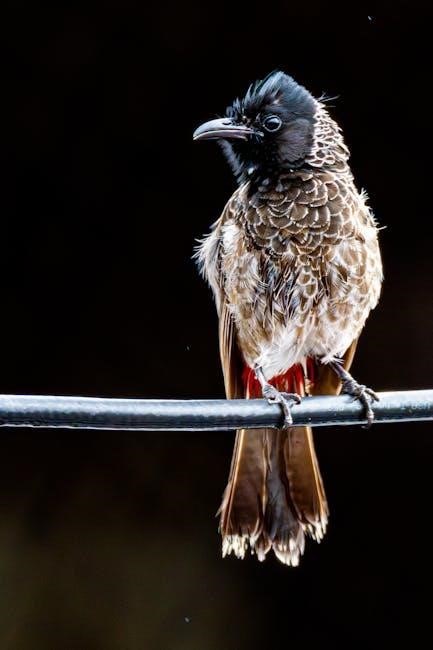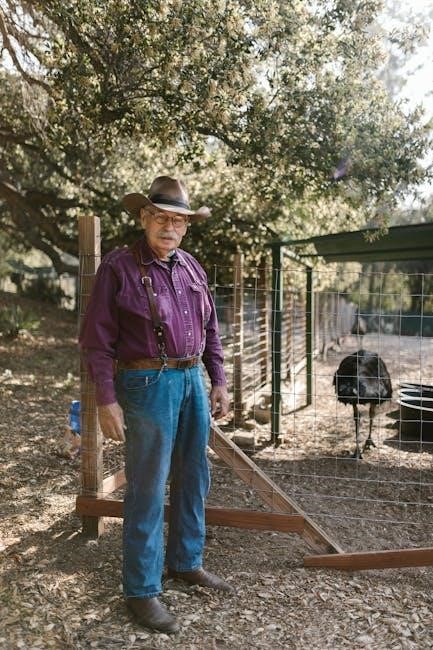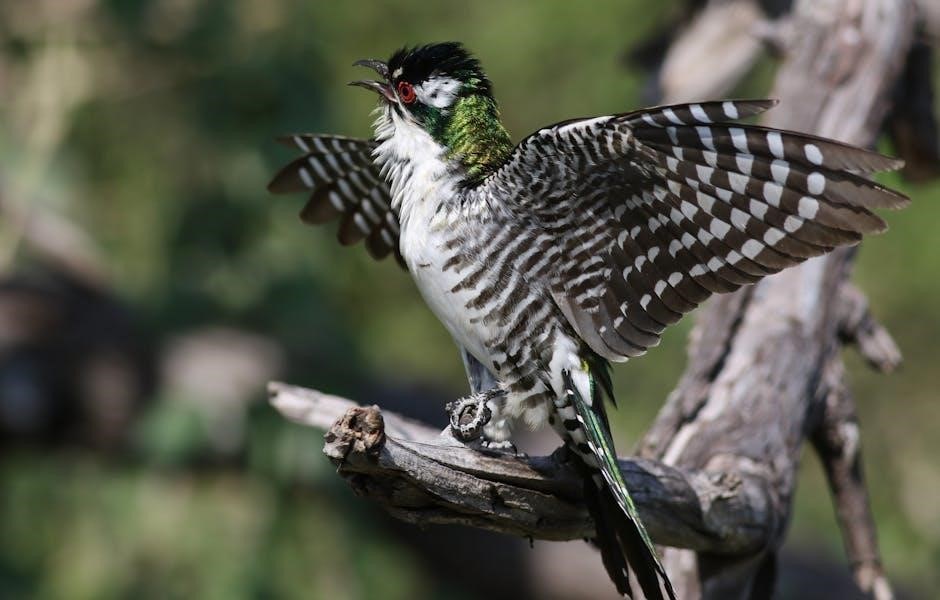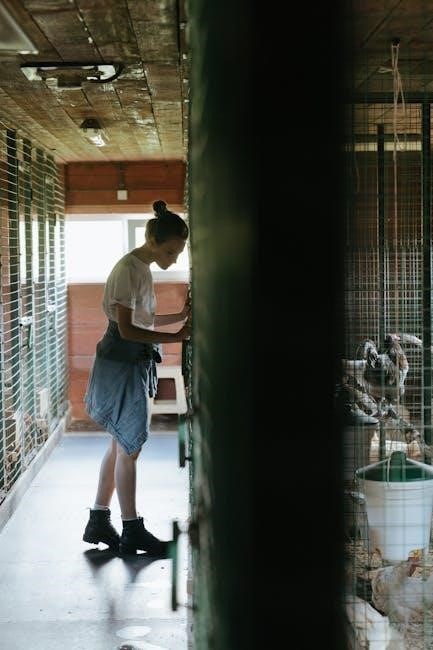Maya Angelou’s poem, a poignant reflection of freedom and race, is deeply connected to her memoir, exploring themes of confinement and liberation with profound emotional resonance․
Overview of the Poem and Its Significance
Maya Angelou’s poem I Know Why the Caged Bird Sings is a powerful exploration of freedom, race, and identity․ It contrasts the caged bird, symbolizing oppression, with a free bird, representing liberation․ The poem reflects Angelou’s personal experiences and the broader African American struggle․ Its vivid imagery and emotional depth resonate universally, making it a landmark of contemporary literature․ The poem’s structure, with its rhythmic cadence, enhances its emotional impact․ It is often studied in educational settings for its historical and cultural relevance․ The work is deeply connected to Angelou’s memoir of the same name, further enriching its autobiographical and societal significance․ Its themes of resilience and hope continue to inspire readers globally․
The Title’s Origin: A Reference to Paul Laurence Dunbar’s “Sympathy”
The title I Know Why the Caged Bird Sings draws inspiration from Paul Laurence Dunbar’s poem “Sympathy․” Dunbar’s work expresses the anguish of a caged bird, resonating with themes of confinement and longing․ Angelou’s adaptation of this imagery underscores the universal struggle for freedom․ The reference acknowledges the historical and literary lineage of the caged bird as a symbol of oppression․ By invoking Dunbar, Angelou connects her work to the broader African American literary tradition․ This nod to Dunbar’s poetry enriches the context of her own exploration of race and identity․ The title’s origin highlights the enduring power of the caged bird metaphor in expressing the human spirit’s quest for liberation and understanding․
Historical and Cultural Context
Set against the backdrop of the Civil Rights Movement, the poem reflects the era’s racial tensions and segregation, offering a powerful critique of societal oppression and inequality․

The Time Period and Geographical Setting
The poem is set in the segregated South, particularly in Stamps, Arkansas, during the 1930s and 1940s․ This period was marked by deep racial divisions and economic hardship․ The geographical setting plays a crucial role in shaping the themes of confinement and freedom, as the rigid social structures of the rural South mirrored the emotional and physical cages described in the poem․ The contrast between the oppressive environment and the longing for liberation reflects the broader experiences of African Americans during this era․ The setting also influences the narrator’s perspective, highlighting the resilience and strength needed to endure such conditions․ The time and place are integral to the poem’s exploration of race, identity, and personal growth․
Social and Cultural Backdrop of the Poem
The poem reflects the harsh realities of racial segregation and discrimination in the rural South during the mid-20th century․ The caged bird symbolizes the oppression faced by African Americans, while the free bird represents the elusive dream of equality․ Social norms enforced a rigid hierarchy, limiting opportunities and perpetuating systemic racism․ The cultural backdrop also highlights the resilience of the African American community, emphasizing the importance of identity and the struggle for freedom․ Personal experiences, such as Maya Angelou’s own encounters with prejudice, enrich the narrative, offering a deeply personal perspective on the broader societal issues․ This interplay of social and cultural elements underscores the poem’s powerful commentary on race and liberation․
Themes and Motifs in the Poem
The poem explores themes of freedom, race, and personal growth, using the caged bird as a metaphor for oppression, reflecting Angelou’s own journey and societal struggles․

Freedom and Confinement: The Central Metaphor
The poem’s central metaphor contrasts the free bird’s joy with the caged bird’s anguish, symbolizing the African American experience of oppression and longing for liberation․ The caged bird represents confinement, while the free bird embodies freedom and hope․ Through this vivid imagery, Maya Angelou conveys the emotional and psychological impact of systemic racism and segregation․ The caged bird’s song becomes a powerful expression of resilience and the enduring desire for freedom․ This metaphor not only highlights the struggles faced by African Americans but also serves as a universal symbol for anyone yearning to break free from societal or personal constraints․ The poem’s imagery and emotion resonate deeply, making it a timeless exploration of freedom and confinement․
Race and Identity: The African American Experience
Maya Angelou’s poem profoundly explores the African American experience through the lens of race and identity․ Set against the backdrop of segregation in Stamps, Arkansas, the poem reflects the collective trauma and resilience of the Black community․ The caged bird serves as a powerful symbol of the oppressive systems that restrict African Americans, while the free bird represents the longing for equality and justice․ Angelou’s work highlights the internalized racism and self-doubt that often accompany systemic oppression, as well as the struggle to reclaim and celebrate one’s identity․ Through vivid imagery and emotional depth, the poem underscores the historical and ongoing fight for racial equality, making it a timeless voice for marginalized communities․
Gender and Personal Growth: Maya Angelou’s Autobiographical Elements
Maya Angelou’s poem intertwines themes of gender and personal growth, reflecting her own journey of self-discovery․ Drawing from her experiences as a Black woman in a segregated society, the poem highlights the challenges of navigating both racial and gender-based oppression․ Angelou’s autobiographical elements reveal her struggle with identity, particularly in adolescence, where societal expectations clashed with her desire for autonomy․ The caged bird metaphor extends to her personal growth, symbolizing her own liberation from the constraints of gender roles and societal norms․ Through her writing, Angelou exemplifies resilience and transformation, offering a powerful narrative of female empowerment and the pursuit of selfhood in the face of adversity․

Structural Analysis of the Poem
The poem’s structure relies on vivid imagery and symbolism, with the caged bird representing oppression․ Its rhyme and rhythm convey emotional depth, enhancing the themes of freedom and confinement․
Imagery and Symbolism: The Caged Bird as a Representation of Oppression

The caged bird is a powerful symbol of oppression, its clipped wings and tied feet embodying the physical and emotional constraints imposed by societal structures․ The bird’s song, though tinged with fear, becomes a cry for freedom, resonating with the struggles of marginalized communities․ Maya Angelou uses vivid imagery to contrast the caged bird with its free counterpart, emphasizing the disparity between confinement and liberation․ This metaphor not only highlights the African American experience but also serves as a universal symbol of resilience and the enduring human spirit’s quest for freedom․ The imagery evokes empathy, urging readers to reflect on the barriers that cage individuals and societies alike․
The Role of Rhyme and Rhythm in Conveying Emotion
Rhyme and rhythm in “I Know Why the Caged Bird Sings” amplify emotional depth, creating a musical quality that underscores the poem’s themes․ The consistent rhyme scheme adds structure, mirroring the caged bird’s confinement, while variations in rhythm convey tension and release․ The syncopated beats evoke the bird’s struggle, transforming each line into a heartbeat of resilience․ This interplay of sound and meter immerses readers in the emotional landscape, heightening the sense of longing and hope․ Angelou’s mastery of rhythm and rhyme transforms the poem into a lyrical testament to the human spirit’s ability to sing even in captivity, making the emotional journey vivid and unforgettable․
Comparisons with Other Works by Maya Angelou
Maya Angelou’s poem resonates with themes of freedom and identity found in her memoir and other poetry collections, showcasing her consistent exploration of personal and societal struggles through lyrical expression․
Connection to Her Memoir “I Know Why the Caged Bird Sings”
The poem shares its title with Maya Angelou’s autobiographical memoir, reflecting her childhood experiences in Stamps, Arkansas․ Both works explore themes of racial oppression, personal growth, and the longing for freedom․ The caged bird symbolizes the constraints of segregation and societal expectations, while the free bird embodies the aspiration for liberation․ The memoir delves into Angelou’s journey of self-discovery, mirroring the emotional depth of the poem․ Specific scenes, such as her memorization of Shakespeare and encounters with racial tension, highlight the struggles that inspired her writing․ The poem and memoir together create a powerful narrative of resilience and hope, bridging the gap between her personal story and universal themes of identity and freedom․
Themes of Freedom and Identity in Her Other Poetry Collections
Maya Angelou’s other poetry collections, such as “Phenomenal Woman” and “Still I Rise,” explore similar themes of freedom and identity․ These works reflect her journey of self-discovery and the societal challenges she faced․ The recurring metaphor of the caged bird in her poetry symbolizes the struggle for liberation, both personal and collective․ Her writing often intertwines personal experiences with broader social issues, creating a powerful narrative of resilience and hope․ Through her poetry, Angelou challenges societal norms and celebrates the strength of the African American spirit, making her works timeless classics in contemporary literature․

Personal Reflections and Autobiographical Elements
Maya Angelou’s poem mirrors her life journey, reflecting childhood struggles, racial identity, and personal growth, weaving her experiences into a powerful narrative of resilience and self-discovery․

Maya Angelou’s Childhood Experiences in Stamps, Arkansas
Maya Angelou’s formative years in Stamps, Arkansas, were marked by racial segregation and personal struggles․ Her experiences there deeply influenced her writing, including the poem․ Growing up in a small, segregated town, she faced discrimination and witnessed the harsh realities of racism․ These early challenges shaped her perspective on freedom and confinement, themes central to her work․ Her relationship with her brother Bailey and her grandmother, Annie Henderson, provided emotional support and instilled resilience․ These childhood experiences are vividly portrayed in her memoir and poetry, offering insight into her journey toward self-discovery and artistic expression․

The Influence of Family and Community on Her Writing
Maya Angelou’s family and community played a pivotal role in shaping her writing․ Her brother Bailey introduced her to literature, fostering her love for words․ Her grandmother, Annie Henderson, provided stability and wisdom, influencing her resilience․ The segregated community in Stamps, Arkansas, exposed her to racism, which became a central theme in her work․ The support of her family and the harsh realities of her community instilled in her a deep sense of identity and purpose․ These experiences are intricately woven into her poetry and memoir, reflecting her journey of self-discovery and the enduring impact of her roots․ Her writing serves as a testament to the power of family and community in shaping her artistic voice․
Societal Implications and Impact
The poem addresses systemic oppression and freedom, resonating deeply with the Civil Rights Movement․ It inspires marginalized voices, fostering dialogue on race and equality, sparking social change․
The Poem as a Reflection of the Civil Rights Movement
Maya Angelou’s poem vividly captures the essence of the Civil Rights Movement through its powerful metaphor of the caged bird․ The bird’s confinement symbolizes the oppression faced by African Americans under segregation and systemic racism․ The poem reflects the struggle for freedom and equality, resonating with the experiences of many during the 1950s and 1960s․ Angelou’s vivid imagery, such as the bird’s clipped wings and barred vision, mirrors the limitations imposed by racial discrimination․ The poem’s themes of resilience and hope align with the movement’s spirit of resistance and the quest for liberation․ By giving voice to these struggles, the poem became an anthem for those fighting for civil rights, embodying the collective longing for justice and equality․ Its emotional depth continues to resonate, making it a timeless reflection of the era’s challenges and aspirations․

Its Reception and Influence on Contemporary Literature
Since its publication, “I Know Why the Caged Bird Sings” has been met with widespread acclaim and has significantly influenced contemporary literature․ The poem’s evocative imagery and powerful exploration of race and freedom have made it a cornerstone of modern poetry․ It has inspired countless writers to address themes of identity and social justice in their work․ The poem’s ability to resonate with diverse audiences has cemented its place in the literary canon․ Its influence extends beyond poetry, impacting memoirs, novels, and other forms of creative expression․ The raw emotion and authenticity in Angelou’s words continue to inspire new generations of writers and readers, ensuring its lasting impact on the literary landscape․ The poem remains a vital voice in the ongoing conversation about race, freedom, and human resilience․

Legacy and Educational Significance
The poem’s enduring relevance has made it a staple in educational curricula, fostering discussions on race, identity, and freedom, enriching students’ understanding of these critical themes․
The Poem’s Role in Educational Curricula
Maya Angelou’s poem is widely taught in schools and universities, serving as a powerful tool for exploring themes of race, identity, and freedom․ Educators often use it to illustrate the use of metaphor and symbolism in literature․ The poem’s emotional depth and historical relevance make it a valuable resource for teaching about the African American experience and the Civil Rights Movement․ Its inclusion in curricula helps students develop critical thinking skills and empathy․ The poem’s accessibility and universal themes ensure its continued relevance in educational settings, making it a cornerstone of many literature and social studies programs․
Its Enduring Relevance in Modern Discussions of Race and Freedom
Maya Angelou’s poem remains a vital voice in contemporary discussions on race and freedom․ Its exploration of oppression and resilience continues to resonate with modern movements for equality; The imagery of the caged bird serves as a powerful metaphor for systemic injustices, bridging historical and present-day struggles․ The poem’s themes of identity and liberation inspire ongoing conversations about racial disparities and the quest for human rights․ Its universal message transcends time, making it a timeless piece that connects past and present, ensuring its relevance in today’s social justice dialogues and efforts toward a more equitable society․
